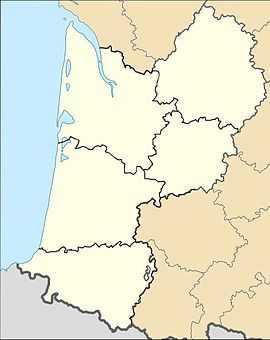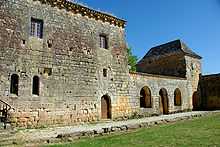Saint-Avit-Sénieur
| Saint-Avit-Sénieur | |
|---|---|
|
The church | |
 Saint-Avit-Sénieur | |
|
Location within Aquitaine region  Saint-Avit-Sénieur | |
| Coordinates: 44°46′32″N 0°49′02″E / 44.7756°N 0.8172°ECoordinates: 44°46′32″N 0°49′02″E / 44.7756°N 0.8172°E | |
| Country | France |
| Region | Aquitaine |
| Department | Dordogne |
| Arrondissement | Bergerac |
| Canton | Beaumont-du-Périgord |
| Intercommunality | Pays Beaumontois |
| Government | |
| • Mayor (2008–2014) | Alain Delayre |
| Area1 | 23.4 km2 (9.0 sq mi) |
| Population (2008)2 | 440 |
| • Density | 19/km2 (49/sq mi) |
| INSEE/Postal code | 24379 / 24440 |
| Elevation |
61–195 m (200–640 ft) (avg. 171 m or 561 ft) |
|
1 French Land Register data, which excludes lakes, ponds, glaciers > 1 km² (0.386 sq mi or 247 acres) and river estuaries. 2 Population without double counting: residents of multiple communes (e.g., students and military personnel) only counted once. | |
Saint-Avit-Sénieur is a commune in the Dordogne department in Aquitaine in southwestern France.
The most notable feature of the village is a massive church from the end of the 11th and 12th century. Next to the church, an abbey has been erected to honour the ermit Avitus, who died in 570. Avitus gave his name to the abbey and the village.
The abbey used to house canons, disciples of Augustine of Hippo. It is now mostly in ruins.
The size of the church (51 x 23 meters) can be explained by the fame of the village on the Way of St. James: one of the paths starting from Vézelay passes through this place.
Situation

The village is located on a plateau near the Couze Valley. In the past, the place was called "Mount Dauriac".
History
Prehistory
The site of Combe-Capelle has been excavated near the Couze Valley, next to the border with the municipality of Montferrand-du-Périgord. The place was occupied in Upper Paleolithic.
Middle Ages
The legend of Avitus
According to an hagiography, Avitus, a young aristocrat from Lanquais was enlisted against his will in the Visigoth army (under Alaric II) against the Frank army of Clovis. The army of Clovis was trying to conquer the South-West of France at this time.
At the Battle of Vouillé in 507, Avitus, made prisoner by the Franks, converts to Christianism. Freed, he dreams that he must return to his homeland and walk inside the forest until he receives a sign.
He rests in a cave next to a fountain, facing a hill, the Mount Dauriac, where a pagan temple is erected. He recites a prayer and the pagan temple collapses.
Avitus them becames a thaumaturge and a healer. At his dead in 570, he was celebrated like a saint. Monks come to settle near the cave where he has built an oratory.
The first church
After the death of Avitus, a first church, called "Notre-Dame-du-Val" was built near his retreat and was destroyed in the 9th or 10th Century, likely by the Normans.
According to an engraved stone visible in the current church, the body of Avit was moved a few kilometers away to the hamlet of Saint-Cernin, now on the municipality of Labouquerie.
After the destruction of the first church, the primitive village disappeared and the monks moved to settle on Mount Dauriac.
The Way of St. James and the new church
A first romanesque church was built in the 11th century on Mount Dauriac, at the same place as the current church.
Many pilgrims came here because of the notoriety of Avitus and because the village was situated on St James Way. To accommodate all these pilgrims, another, larger church was built to replace the existing one, at the same place, at the end of the 11th and beginning of the 12th century.
Destructions
12th or 13th centuries
According to traces of fire on the walls, the village and the abbey were partially destroyed in the 12th and 13th centuries. Several hypothesis have been made as to the cause of these destructions: pillage by the cathars or consequence of the Hundred Years' War.
16th century

During the religious wars, in 1577, the lord of Commarque and some Protestants entered the abbey, destroyed a large part of the buildings and killed the priests.
The chapter was suppressed in 1695.
Recent History
In 1862, the church is classified as a "Monument historique". At the end of the 19th century, the church is restored by the architect Henri Rapine.
Achaeological excavations during the 1960s have found what could be the remains of a pagan temple: tiles like the ones used by the Romans and holes that could have sustained pillars. This temple could have existed before the church and was likely destroyed by an earthquake.
Places and monuments
The church
The primitive church
On the site of the current church, a primitive church had existed up to the middle of the 11th century. A part of its southern wall is still visible in the wall of the current church.
This primitive church was probably erected by monks of the Order of Saint Benedict.
The current church
The current church was erected during the romanesque period, at the end of the 11th century and beginning of the 12th. At the beginning of the 12th century, the body of Avitus was transferred here, as it is written in an engraved stone in the wall of the church.
The building was erected by canons of Saint Augustine.
The outside
- Western façade
The North tower was partially destroyed during the religious wars.
- Southern wall
This wall is adjoined to the ruins of the cloister. There are marks of fire in its lower part. The fire could have been caused by either the Cathars in 1214 or the English in 1442 during the Hundred Years' War.
- Eastern apse
A few tombs of monks and aristocrats are located at the bottom of the apse.
The inside
Three bays are delimited by massive pillars. These pillars were probably made to sustain domes.
Instead of the domes, rib vaults are currently erected. Contrary to the wall and pillars, they do not exhibit the red marks of the fire of the 13th century. Therefore, it is possible that the building was initially covered by domes from its beginning to the fire in the 13th century, like in the Cathedral of Périgueux or of Cahors.
The figures at the top of the vaults show a blessing hand, a standing character and a Lamb of God.
Paintings are also visibles on the walls. A representation of Saint Christopher can be seen among them.
The holy water font at the entrance is from the 9th century. Therefore, it is possible that it was moved from the previous church Notre-Dame-du-Val.
The altar is contemporary (end of the 20th century).
The flat chevet is dated 1577 and was therefore made after the religious wars.
Ruins of the abbey
Only external walls remains from the cloister adjoined to the South wall of the church. We can see, inside this walls, holes for the beams that sustained the roof of the cloister. The cloister was used as a cemetery from 1659 to 1923.

The chapter house still remains. A small museum with the remains of the 20th century archaeological excavations is shown inside. Between the chapter house and the church, the sacristy and above, the previous dormitory of the monks also remain. Inside the dormitory, a small geological museum can be seen (donation of Jean Capelle).
Next to the chapter house, the entrance porch is also visible.
On the South wall of the cloister, remains of several rooms can be seen in the walls and on the ground: the kitchen (remains of a bread owen), the dining room, the scriptorium, the cellar (covered nowadays).

To the South an old rectory from the 17th century (the first floor is probably older) is used today for temporary exhibitions.
The rectory is surrounded by fortified walls. To its west, more remains of foundations can be seen and could have been houses.
Place du fort

This square is situated at the North of the church. Old houses with gothic or renaissance windows, a fragment of the wall of the 14th century and a sundial can be seen there. One of the house has the inscription "Chanoine Fadelpech 1628".
Population
| Historical population | ||
|---|---|---|
| Year | Pop. | ±% |
| 1793 | 1,121 | — |
| 1800 | 1,032 | −7.9% |
| 1806 | 1,122 | +8.7% |
| 1821 | 1,197 | +6.7% |
| 1831 | 1,207 | +0.8% |
| 1836 | 1,203 | −0.3% |
| 1841 | 1,374 | +14.2% |
| 1846 | 1,450 | +5.5% |
| 1851 | 1,475 | +1.7% |
| 1856 | 1,480 | +0.3% |
| 1861 | 1,456 | −1.6% |
| 1866 | 1,345 | −7.6% |
| 1872 | 1,272 | −5.4% |
| 1876 | 1,225 | −3.7% |
| 1881 | 1,212 | −1.1% |
| 1886 | 1,134 | −6.4% |
| 1891 | 1,081 | −4.7% |
| 1896 | 1,009 | −6.7% |
| 1901 | 951 | −5.7% |
| 1906 | 870 | −8.5% |
| 1911 | 853 | −2.0% |
| 1921 | 721 | −15.5% |
| 1926 | 706 | −2.1% |
| 1931 | 645 | −8.6% |
| 1936 | 634 | −1.7% |
| 1946 | 586 | −7.6% |
| 1954 | 518 | −11.6% |
| 1962 | 506 | −2.3% |
| 1968 | 464 | −8.3% |
| 1975 | 394 | −15.1% |
| 1982 | 385 | −2.3% |
| 1990 | 365 | −5.2% |
| 1999 | 404 | +10.7% |
| 2008 | 440 | +8.9% |
See also
References
| Wikimedia Commons has media related to Saint-Avit-Sénieur. |